Managing a thriving campground demands a delicate balance of hospitality, operational efficiency, and environmental stewardship. From the crack of dawn when early risers spark their first campfire to the quiet evening hours under starlit skies, successful campground management orchestrates countless moving parts into a seamless outdoor experience.
Transform your campground into a well-oiled operation by mastering three core areas: guest experience, facility maintenance, and natural resource protection. Create detailed daily checklists for your staff, covering everything from washroom sanitation to trail inspection. Implement a robust reservation system that handles peak season demands while maintaining emergency sites for unexpected arrivals. Most importantly, develop clear protocols for wildlife encounters, weather emergencies, and facility maintenance that keep both staff and campers safe.
Modern campground management extends beyond traditional hospitality – it’s about creating memorable outdoor experiences while preserving natural spaces for future generations. Whether you’re overseeing a intimate family campground or a sprawling recreational facility, success lies in anticipating needs, maintaining consistent standards, and fostering a connection between visitors and nature.
This comprehensive approach to campground management ensures your facility not only operates smoothly but also creates lasting memories for every guest who pitches a tent under your stewardship.
Essential Systems for Daily Operations
Reservation Management
Efficient reservation management is the backbone of any successful campground operation. Using a reliable reservation management system helps streamline bookings and maintain accurate occupancy records, making your daily operations smoother.
Start by establishing clear booking procedures. Create a user-friendly process that captures essential information: guest details, length of stay, site preferences, and any special requirements. Pro tip: maintain a detailed calendar that shows all reservations at a glance, helping you maximize site utilization and prevent double bookings.
For check-ins, develop a standardized procedure that includes site assignment confirmation, payment verification, and sharing campground rules. We’ve found that providing a welcome package with a site map, emergency contacts, and local attractions helps create a positive first impression and reduces common questions later.
Keep detailed occupancy records not just for administrative purposes, but also to identify booking patterns. This data proves invaluable for future planning and marketing strategies. For instance, knowing your peak periods helps you adjust staffing levels and maintenance schedules accordingly.
Consider implementing a waitlist system for popular weekends and maintaining a cancellation policy that’s fair to both the campground and guests. Remember to regularly back up your reservation data and keep physical copies of important documents as a backup.
The key to successful reservation management is finding the right balance between efficiency and personal touch. While automation helps with organization, remember that camping is about creating memories, so maintain that warm, welcoming atmosphere in all your guest interactions.
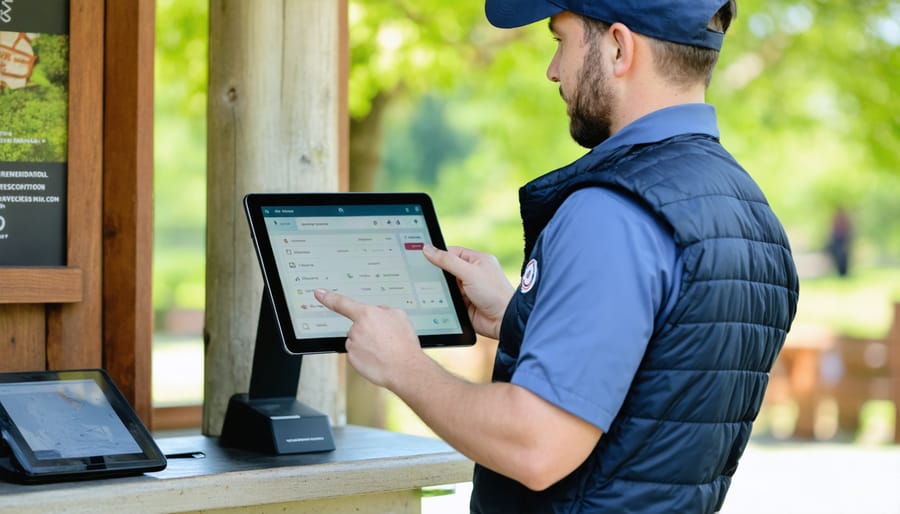
Staff Scheduling and Training
Managing staff at a campground requires a careful balance of scheduling and comprehensive training to ensure smooth operations throughout the season. Create a rotating schedule that accounts for peak visitor times, typically weekends and holidays, when you’ll need more hands on deck. Pro tip: Always schedule at least one experienced staff member per shift to support newer team members.
Training should begin with essential safety protocols, including emergency procedures, first aid, and wildlife encounter management. Make sure every team member understands the campground’s layout and can confidently direct visitors to amenities, trails, and emergency exits. Consider cross-training staff in different roles – from registration to maintenance – to maintain flexibility in your scheduling.
Organize regular team meetings to discuss upcoming events, share feedback, and address any concerns. These gatherings are perfect opportunities for ongoing training and building team spirit. Create detailed training manuals that staff can reference, including standard operating procedures, campground policies, and common troubleshooting solutions.
For seasonal staff, schedule training sessions well before peak season begins. Include hands-on practice with reservation systems, maintenance equipment, and customer service scenarios. Remember to incorporate environmental education into your training program – staff should understand and be able to communicate your campground’s conservation efforts to visitors.
Keep communication channels open through group chats or daily logs, ensuring important information is passed between shifts. This helps maintain consistency in service and keeps everyone informed about ongoing situations or special guest needs.
Maintaining Park Standards
Facility Maintenance Schedule
A well-maintained campground keeps visitors happy and operations running smoothly. Here’s a comprehensive breakdown of essential maintenance tasks to keep your facilities in top shape.
Daily Tasks:
– Clean and sanitize washrooms and shower facilities twice daily during peak season
– Empty garbage bins and recycling containers
– Check water pressure and temperature in shower facilities
– Inspect playground equipment for safety issues
– Clean common areas and picnic shelters
– Walk the grounds to remove any litter
– Test water quality at designated swimming areas
Weekly Tasks:
– Mow grass and trim around campsites
– Clean and maintain fire pits
– Check and repair picnic tables
– Inspect and clear hiking trails
– Clean signage and information boards
– Test emergency systems and lighting
– Deep clean shower facilities
Seasonal Tasks:
Spring:
– Remove winter debris and fallen branches
– Repair winter damage to facilities
– Install dock systems and water equipment
– Turn on water systems and check for leaks
– Paint and repair picnic tables and facilities
Fall:
– Winterize water systems and buildings
– Store seasonal equipment
– Remove dock systems
– Clear gutters and drainage systems
– Conduct major repairs before winter
Pro tip: Create a digital maintenance checklist that staff can access via mobile devices, making it easier to track completed tasks and identify recurring issues. Consider implementing an eco-friendly cleaning program using biodegradable products to protect the surrounding environment.
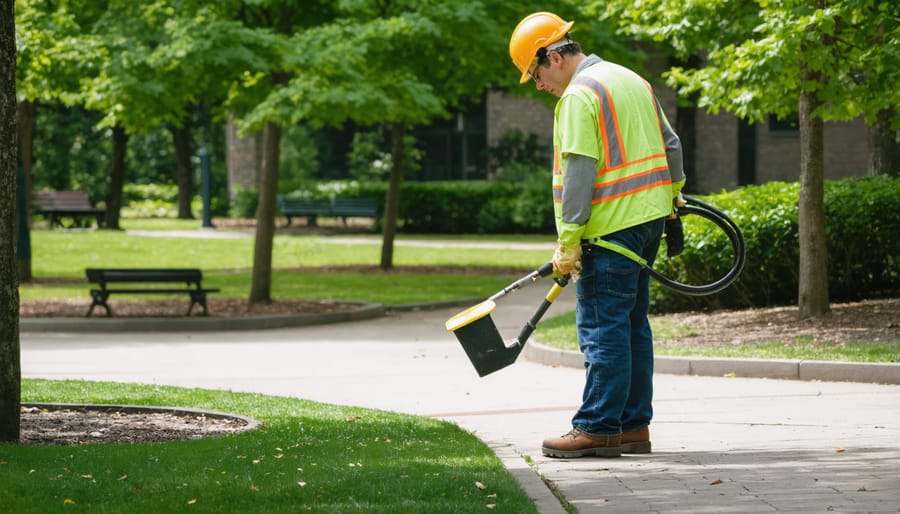
Campsite Quality Control
Regular campsite inspections are the backbone of maintaining a high-quality outdoor experience for your visitors. Following established campground rules and standards ensures consistency and safety across your facility.
Start each day with a morning walkthrough of all sites, checking for leftover trash, fire pit conditions, and potential hazards. Pay special attention to picnic tables, ensuring they’re clean and structurally sound. Look for loose boards, protruding nails, or signs of wear that might need immediate attention.
Create a detailed checklist for your staff that includes:
– Cleaning and sanitizing shared facilities
– Inspecting water spigots and electrical hookups
– Monitoring ground conditions for drainage issues
– Checking trail markers and site number posts
– Examining trees for dangerous branches
Pro tip: Keep a digital log of inspections using a tablet or smartphone app. This helps track recurring issues and maintenance patterns, making it easier to anticipate future needs.
Don’t forget to regularly test emergency equipment and verify that first aid stations are fully stocked. Maintain clear communication channels between inspection staff and maintenance crews to ensure quick resolution of any issues discovered during quality checks.
Remember, happy campers often become repeat visitors, so maintaining high standards isn’t just about safety – it’s about creating lasting memories and building a loyal customer base.
Environmental Protection Measures
Protecting our natural environment is crucial for maintaining the beauty and integrity of your campground for future generations. Following established environmental protection guidelines ensures your campground remains a thriving ecosystem while providing memorable experiences for visitors.
Start by implementing a comprehensive waste management system. Set up clearly marked recycling and composting stations throughout the campground, and educate visitors about proper waste sorting. Consider installing bear-proof containers to prevent wildlife encounters and maintain a clean environment.
Water conservation is another vital aspect. Install low-flow fixtures in washroom facilities and implement rainwater collection systems for garden maintenance. Regular monitoring of water quality in nearby lakes or streams helps detect potential issues early.
Protect local flora by establishing designated trails and camping areas. This prevents soil erosion and preserves native plant species. Create buffer zones around sensitive areas and waterways to maintain natural habitats for wildlife.
Encourage visitors to use environmentally friendly products by offering eco-friendly alternatives in your camp store. From biodegradable soap to reusable water bottles, these small changes make a big difference.
Consider implementing renewable energy solutions where possible. Solar-powered lighting for common areas and energy-efficient appliances in facilities can significantly reduce your environmental footprint while setting a positive example for visitors.
Regular staff training on environmental best practices ensures consistent application of these measures across all campground operations.
Visitor Experience Management
Communication Protocols
Clear communication is the backbone of a well-run campground, and establishing effective protocols can make all the difference. Start by implementing comprehensive visitor management protocols that keep everyone informed and safe.
Create a multi-channel communication system that includes physical signage, digital updates, and in-person interactions. Post clear, weather-resistant signs at key locations showing campground maps, rules, and emergency procedures. Maintain an updated bulletin board near the main office for daily announcements, weather alerts, and upcoming activities.
Equip your staff with two-way radios for instant communication during emergencies or when immediate assistance is needed. Establish a chain of command for information flow, ensuring messages reach the right person quickly and efficiently.
Consider implementing a campground app or text alert system for real-time updates about weather warnings, site availability, or special events. Train your staff to communicate professionally and consistently, using a friendly but authoritative tone when sharing information or enforcing rules.
Maintain a logbook at the main office to track important communications, incidents, and visitor feedback. This creates a valuable record for future reference and helps identify patterns in visitor needs or concerns. Remember to regularly review and update your communication procedures based on seasonal changes and visitor feedback.
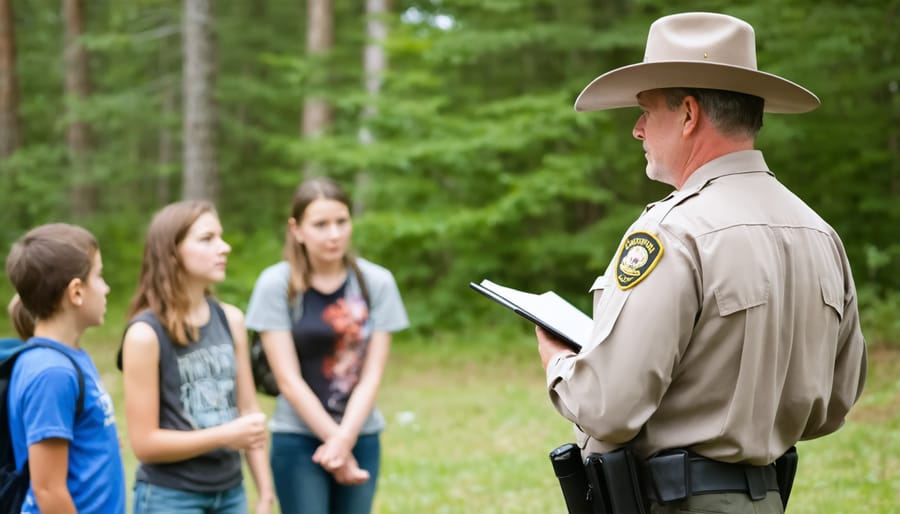
Emergency Response Planning
Having a robust emergency response plan is crucial for maintaining a safe and well-managed campground. Start by creating detailed procedures for common emergencies like medical incidents, severe weather, and wildlife encounters. Keep emergency contact numbers prominently displayed in the office and provide staff with easy-to-follow response flowcharts.
Set up a communication system that works even during power outages – we recommend having both radio systems and satellite phones as backups. Train your staff regularly in first aid, CPR, and basic emergency protocols. Pro tip: conduct mock emergency drills during off-peak seasons to keep everyone sharp and identify areas for improvement.
Establish clear evacuation routes and ensure they’re well-marked throughout the campground. Create designated emergency meeting points and make sure all campers receive this information during check-in. Keep emergency supplies stocked, including first aid kits, flashlights, and weather radios at strategic locations.
Work closely with local emergency services to familiarize them with your campground layout. Maintain updated maps showing access points and water sources for firefighting. Consider installing emergency call boxes at key locations throughout the grounds.
Remember to review and update your emergency procedures annually, incorporating lessons learned from any incidents and feedback from staff and emergency responders. Keep detailed records of all emergency-related events to help refine your response protocols over time.
Conflict Resolution
In any campground, conflicts and complaints are bound to arise, but handling them professionally and promptly can turn challenging situations into opportunities for improved guest satisfaction. Start by actively listening to visitor concerns without interruption, showing empathy, and maintaining a calm demeanor even in heated situations.
Common conflicts often revolve around noise levels, site boundaries, or shared facility usage. Establish clear quiet hours and campground rules, making them visible at check-in and throughout the grounds. When addressing noise complaints, approach the situation diplomatically by first giving a friendly reminder rather than immediate enforcement.
For site boundary disputes, keep a site map handy and be prepared to physically walk the grounds with campers to clarify boundaries. When dealing with facility-related conflicts, implement fair usage policies and posted schedules for amenities like shower buildings or washing stations.
Create a standardized complaint resolution process that includes documenting incidents, following up with involved parties, and maintaining records for future reference. Train staff to recognize when situations require escalation to management and provide them with clear guidelines for handling common scenarios.
Sometimes, offering simple solutions like moving a party to a different site or providing extra firewood can quickly resolve tensions. Remember that word travels fast in camping communities – how you handle conflicts can significantly impact your campground’s reputation.
Seasonal Planning and Adaptation
Peak Season Management
Peak season at your campground can feel like orchestrating a symphony with a thousand moving parts. Success lies in careful planning and having robust systems in place for managing peak season crowds effectively.
Start by implementing a dynamic staffing schedule that allows for flexibility during busy periods. Cross-train your team members so they can pitch in where needed, whether it’s at check-in, maintenance, or cleaning services. Consider hiring seasonal staff early and providing comprehensive training before the rush begins.
Streamline your reservation system to handle high volumes efficiently. Use digital tools to automate bookings and maintain clear communication with guests. Set up a waitlist system for cancellations and establish clear policies for no-shows to maximize occupancy.
Create designated overflow areas for busy weekends and have contingency plans ready for common scenarios like weather events or facility maintenance. Stock up on essential supplies well in advance, and establish relationships with reliable local suppliers who can deliver on short notice.
Regular maintenance checks become even more crucial during peak season. Schedule daily inspections of high-traffic areas like washrooms, shower facilities, and common spaces. Consider implementing a rotating cleaning schedule that increases frequency during busier hours.
Communication is key – use clear signage throughout the grounds and maintain an active presence on social media to keep guests informed about facility updates, special events, or capacity status. Consider implementing a campground host program where experienced campers can assist with minor issues and help create a welcoming community atmosphere.
Remember to take care of your staff during these hectic times. Schedule regular team meetings to address concerns and celebrate successes, and ensure everyone gets adequate breaks to maintain high service standards.
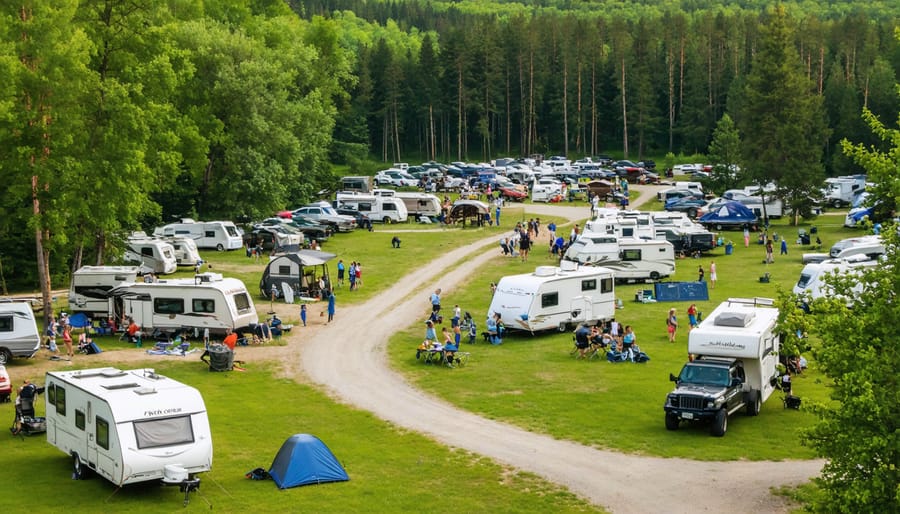
Off-Season Preparations
The off-season is your golden opportunity to prepare your campground for another successful year. In Ontario, this typically falls between late October and early April, when the crisp air and quiet atmosphere create perfect conditions for maintenance and improvements.
Start by conducting a thorough inspection of all facilities. Check every campsite, washroom, and common area for wear and tear. Create a detailed checklist of repairs needed, from loose picnic table boards to damaged fire pits. This is also the ideal time to trim overhanging branches, clear hiking trails, and address any drainage issues that became apparent during the busy season.
Winter is perfect for updating your booking system and reviewing your policies. Take time to analyze the previous season’s data – which sites were most popular? What were common visitor complaints? Use these insights to make informed decisions about pricing and site improvements.
Don’t forget about your equipment maintenance. Service all vehicles, generators, and tools while they’re less in demand. Consider upgrading outdated equipment or investing in new amenities that could enhance camper experience, like improved Wi-Fi systems or updated shower facilities.
Pro tip: Use the off-season to connect with local suppliers and negotiate better rates for the upcoming year. Many vendors offer discounts during slower periods, helping you save on everything from firewood to cleaning supplies.
Finally, focus on staff training and development. Update emergency procedures, refresh customer service protocols, and plan team-building activities. Consider sending key staff members to industry workshops or certification programs – they’ll return with fresh ideas and enhanced skills for the busy season ahead.
Remember, a well-planned off-season leads to a smoother, more profitable peak season. Think of it as your campground’s annual reset button, setting the stage for another year of memorable outdoor experiences.
Managing a campground is both a rewarding and challenging endeavor that requires dedication, attention to detail, and a deep commitment to preserving our natural spaces. By implementing the strategies and best practices we’ve discussed, you can create an unforgettable outdoor experience for visitors while protecting the environment for future generations.
Remember that successful campground management is about finding the right balance between visitor satisfaction and environmental stewardship. Regular maintenance, clear communication with guests, and proper safety protocols form the foundation of a well-run facility. Equally important is the implementation of sustainable practices, from water conservation to waste management programs.
Stay flexible and adaptable as seasonal changes and varying visitor needs require different approaches throughout the year. Building strong relationships with your staff, local community, and emergency services will prove invaluable in maintaining smooth operations.
Consider investing in eco-friendly infrastructure upgrades when possible, such as solar lighting or water-efficient fixtures. Encourage visitors to embrace Leave No Trace principles and create educational opportunities that foster appreciation for nature.
As you move forward in your campground management journey, remember that every decision you make impacts both your guests’ experience and the natural environment. By maintaining high standards of service while prioritizing environmental conservation, you’ll create a sustainable operation that brings joy to campers while preserving Ontario’s beautiful wilderness for years to come.

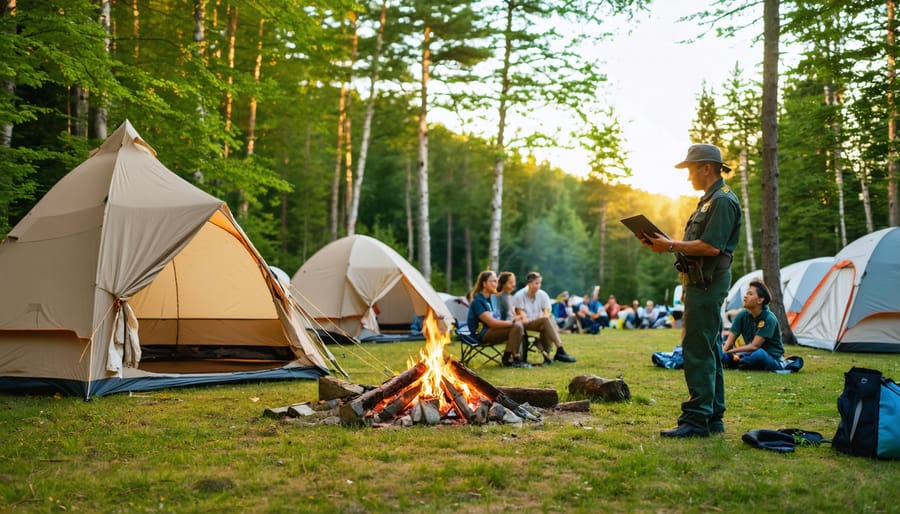
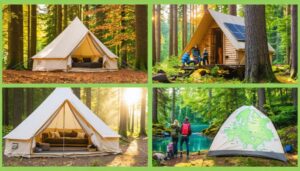
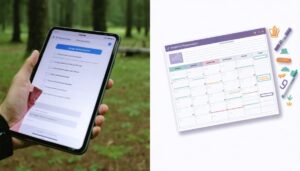




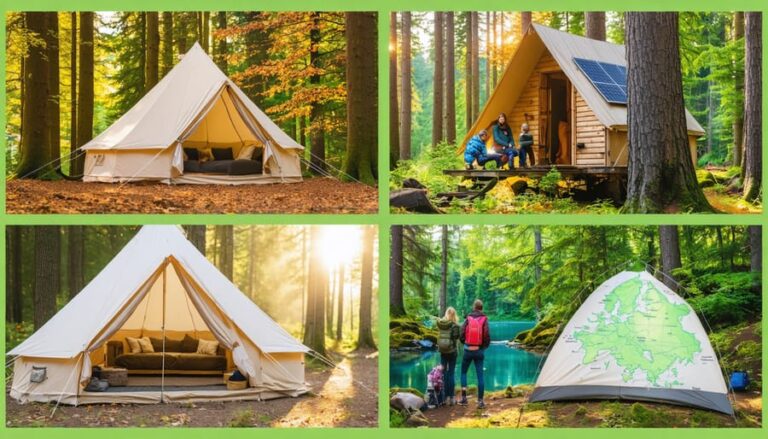




+ There are no comments
Add yours